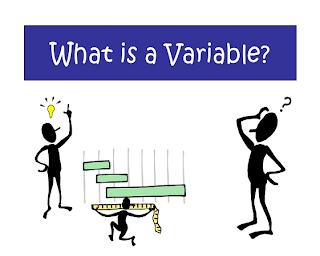Variables :
Such a concept having different quantities changing with time, place or situation is called a variable. For example, rate of crimes, political consciousness and unemployment are social conditions. Intelligence, obedience to law are social values. Their quantity or rate changes in a society and these can be measuredthough research so these are called variables.
Such concepts, values or social conditions which do not change according to the nature of research, are called constant variables. ‘For example, measure of intelligence variables, age group and gender is taken as constant. If ten year, age boys’ intelligence is to be measured, then ten years age and boys are constant
while intelligence is the variable. These variables which are taken as constants are called control variables.
Forms of Variables
i. Continuous variable :Such a variable changing within its limits and get every value, is called continuous variable. Just as age is a continuous variable.
ii. Discrete variable :
Such a variable having a discrete variability. In other words, when there is big or small variation just as petrol may range from 50 to 60 rupees. Same is the case with various grades of education.
iii. Qualitative variables :
Such a variable used for the description of a case or quality. It points out such values or concepts which are not able to be measured just as goodness, vice, love, sincerity and beauty.
iv. Quantitative Variables :
A variable that can be measured mathematically. For examples, age, weight, etc.
Types of Variables
1. Independent Variables :Such a variable of which effect, a researcher wants to be reviewed in his research. For example, the relation of income and standard of life. Here income is an independent variable because its effects appear directly on standard of living. A general principle is that when a researcher wants to study the effects of social condition then social condition is called independent variable.
2. Dependent Variable :
It is a variable that appears as a result of some research. For example, the more the attention of parents to educate their children, the more the educational standard of children will be. In this statement, attention is an independent variable whereas the educational condition is a dependent variable. A general principle is that cause is independent variable and an effect is dependent variable.
3. Extraneous Variable :
Such a variable is affecting a dependent variable. In a study to find the effects on educational ability on seeing television, the nature of programmes on TV as other opposed extraneous variables. If a child looks educational programmes on TV, the effects of ability will be different on the children seeing the TV programmes other than educational programmes for the same length of time.
4. Intervening Variable :
A variable between dependent and independent variable makes the cause more important and the relation of the“ dependent variable becomes more effective. For example, a hypothesis may be like this. Intelligent students in better educational environment give high results. In this hypothesis; intelligent student is an independent variable. High results are a dependent variable and educational environment is an intervening variable which increases the effect of relation.
Indicators :
In the social research, human behaviour, social condition and some variable quality are measured according to some final quantities or measures. These are called indicators. There may be more than one indicator for the measurement of a variable. For instance, income is a variable, its indicators may be:
(i) Income :
1. Less income - two or less than two thousands.
2. Average income - two or more than two thousands.
3. High income - ten or more than ten thousands.
(ii) Educational level :
1. Illiterate 2. Primary pass 3. Matric pass 4. Graduate 5. Master degree or more
Social Interaction :
A Social interaction can make more than one indicators :
1. Duration of Interaction :
i. A few minutes daily
ii. About two hours daily
iii. More than two hours daily
2. Frequency of Interaction :
i. Once a day
ii. Twice to five times a day
iii. More than five times a day
3. Physical Proximity during Interaction :
i. Secret distance during interaction
ii. Personal distance during interaction
iii. Social distance during interaction
iv. Public distance during interaction













0 Comments